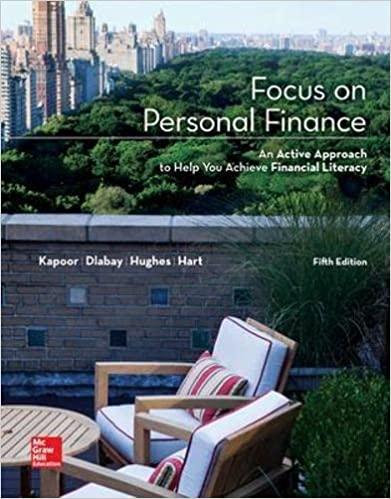Question
1. A beta coefficient for a risky stock is A. greater than 1.0. B. less than 1.0. C. negative. D. equal to 1.0. 2. What
1. A beta coefficient for a risky stock is
A. greater than 1.0.
B. less than 1.0.
C. negative.
D. equal to 1.0.
2.What is the required return using the CAPM if the stock's beta is 1.2, and the individual, who expects the market to rise by 13.2%, can earn 6.4% investedin a risk-freeTreasury bill?
A. 11.62%
B. 9.46%
C. 14.56%
D. 24.58%
3. The present value of an annuity due is
A. greater thanthe present valueof an ordinary annuity.
B. greater than the cost of the annuity.
C. less than the presentvalue of an ordinary annuity.
D. less than the cost of the annuity.
4.If the interest rate on an account is 8 percent annually,what is the present value of $40,000 to be received5 years from today?
A. $22,073 B. $6,188 C. $27,223 D. $10,018
5.Liabilities equal
A. assets.
B. equity.
C. equity minus assets.
D. assets minus equity.
6.The current ratio excludes
A. cash equivalents.
B. accrued interest.
C. inventory.
D. paid-in capital.
7.If you deposit $700 in an account today, and the money grows to $1,800 in 14 years, what rate of annual interesthave you earned?
A. 10 percent
B. 7 percent
C. 50 percent
D. 4 percent
8.Which of the following is calculated by adding total liabilities plus equity?
A. Total assets
B. Inventory
C. Hidden assets
D. Operating income
9.If $800 is deposited in a savings account that pays an interestrate of 5 percent annually,how much money will be in the account after 15 years?
A. $1,609 B. $238 C. $1,663D. $384
10.Which of the following is calculated by subtracting the cost of goods sold and administrative expense from net sales?
A.Total liabilities
B.Operating income
C.Inventory cost
D.Accounts receivable
11.What is the expected return on a stock if the firm will earn 24% during a period of economic boom, 14% during normal economic periods,and 2% during a period of recession, if the probabilities of these economic environments are 20%, 65%, and 15%, respectively?
A. 14.2%
B. 13.6%
C. 8.7%
D. 10.1%
12.Which of the following would be the most likely cause of an increasein inventory turnover?
A.Lowered sales
B.The faster collection of accounts receivable
C.A reduction in the price of the product
D.An increase in the inventory level
13.If an account currently has a value of $84,000and earns an interest rate of 4 percentannually, for how many years can you withdraw$10,000 from the account?
A.10
B.8
C.20
D.12
14.Discounting determines the worth of funds to be received in the future in terms of their
A. present value.
B. future value.
C. cost factor.
D. time factor.
15.If you deposit $10,000 in an investment that yields 6 percent annually,how many years will it take for your investmentto double in value?
A. 12 years
B. 15 years
C. 18 years
D. 20 years
16.What is the future value of an ordinary annuity if you deposit $1,500 per year for the next 5 years into an account that earns an interest rate of 5 percent annually?
A. $8,288 B. $6,322 C. $1,914 D. $7,500
17.If an account has an annual interest rate of 6 percent,what is the present value of $1,000,000 to be received10 years from today?
A. $356,984 B. $1,790,848 C. $789,633 D. $558,395
18.What is the future value of an annuity due if you deposit $1,500 per year for the next 5 years into an account that earns an interestrate of 5 percent annually?
A. $8,288 B. $7,500 C. $8,703
D. $11,914
19.At an interest rate of 6.25% percent compounded annually, how many years will it take for an investment of $7,000 to grow to $10,000? (Round to the nearest year.)
A.6 years
B.8 years
C.4 years
D.10 years
20.To measure risk, the capital asset pricing model uses
A. the volatility of an asset'scash flows.
B. the termduring which theasset is held.
C. beta.
D. an asset'sstandard deviation.
Step by Step Solution
There are 3 Steps involved in it
Step: 1

Get Instant Access to Expert-Tailored Solutions
See step-by-step solutions with expert insights and AI powered tools for academic success
Step: 2

Step: 3

Ace Your Homework with AI
Get the answers you need in no time with our AI-driven, step-by-step assistance
Get Started


